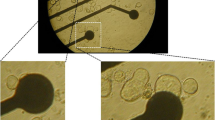Summary
-
1.
Coupling mechanisms between ciliary beating and the membrane potential in Paramecium were investigated under voltage clamp applying intracellular pressure injection of cAMP, cGMP and Ca-EGTA buffer. Ciliary responses following step changes in membrane potential were recorded by high-speed video on magnetic tape.
-
2.
Injections of cAMP and cGMP up to millimolar concentrations caused no detectable changes in the frequency voltage relationship. A minor effect was that the ciliary reorientation towards the anterior cell end (reversal) tended to be inhibited with depolarization up to 10 mV.
-
3.
Injection of Ca2+ into the cell clamped at the resting potential caused a transient anteriad ciliary reorientation and a simultaneous increase in the beating frequency.
-
4.
Injection of EGTA (to buffer Ca2+ below 10−8 M) was ineffective in relation to frequency for several minutes. After this time, hyperpolarization- and depolarization activated frequency responses of EGTA-injected cells were increasingly inhibited. The ciliary reorientation following depolarization was not affected by EGTA.
-
5.
A posterior contraction of the cell diameter was noticed upon membrane hyperpolarization. The contraction coincided in time with the increase in beating frequency.
-
6.
The results support the view that the voltage-dependent augmentation of the ciliary beating rate is not directly mediated by an intracellular increase in either cAMP or cGMP.
-
7.
The role of Ca2+ as intracellular messenger in the ciliary and somatic compartments is discussed.
Similar content being viewed by others
References
Arreola J, Calvo J, Garcia MC, Sanches JA (1987) Modulation of calcium channels of twitch skeletal muscle fibers of the frog by adrenaline and cyclic adenosine monophosphate. J Physiol 393:307–331
Bonini NM, Nelson DL (1988) Differential regulation of Paramecum ciliary motility by cAMP and cGMP. J Cell Biol 106:1615–1623
Bonini NM, Gustin MC, Nelson DL (1986) Regulation of ciliary motility by membrane potential in Paramecium: a role for cyclic AMP. Cell Motility Cytoskel 6:256–272
Brehm P, Eckert R (1978) An electrophysiological study of the regulation of ciliary beating frequency in Paramecium. J Physiol 283:557–568
Brehm P, Dunlap K, Eckert R (1978) Calcium-dependent repolarization in Paramecium. J Physiol 274:639–654
Brehm P, Eckert R, Tillotson D (1980) Calcium-mediated inactivation of Ca current in Paramecium. J Physiol 306:193–203
De Peyer JE, Machemer H (1978) Are receptor-activated ciliary motor responses mediated through voltage or current? Nature 276:285–287
De Peyer JE, Machemer H (1982a) Electromechanical coupling in cilia I. Effects of depolarizing voltage steps. Cell Motility 2:483–496
De Peyer JE, Machemer H (1982b) Electromechanical coupling in cilia II. Effects of hyperpolarizing voltage steps. Cell Motility 2:497–508
Dunlap K (1977) Localization of calcium channels in Paramecium caudatum. J Physiol 271:119–133
Eckert R (1972) Bioelectric control of ciliary activity. Science 176:473–481
Fortner H (1925) Über die Gesetzmäßigkeit der Wirkungen des osmotischen Druckes physiologisch indifferenter Lösungen auf einzellige tierische Organismen. Biol Zbl 45:417–446
Gustin MC, Nelson DL (1987) Regulation of adenylate cyclase by Ca2+ in Paramecium. Biochem J 246:337–345
Hartzell HC, Fischmeister R (1986) Opposite effects of cyclic GMP and cyclic AMP on Ca2+ current in single heart cells. Nature 323:273–276
Hennessey TM, Machemer H, Nelson DL (1985) Injected cyclic AMP increases ciliary beat frequency in conjunction with membrane hyperpolarization. Eur J Cell Biol 36:153–156
Izumi A, Nakaoka Y (1987) cAMP-mediated inhibitory effect of calmodulin antagonists on ciliary reversal of Paramecium. Cell Motility Cytoskel 7:154–159
Koizumi S (1974) Microinjection and transfer of cytoplasm in Paramecium. Exp Cell Res 88:74–78
Kramer RH, Levitan ES, Wilson MP, Levitan IB (1988) Mechanism of calcium-dependent inactivation of a potassium current in Aplysia neuron R15: Interaction between calcium and cyclic AMP. J Neurosci 8:1804–1814
Machemer H (1972) Properties of polarized ciliary beat in Paramecium. Acta Protozool 11:295–300
Machemer H (1974) Frequency and directional responses of cilia to membrane potential changes in Paramecium. J Comp Physiol 92:293–316
Machemer H (1986) Electromotor coupling in cilia. In: Lüttgau HC (ed) Membrane control of cellular activity. Fortschr Zool 33:205–250
Machemer H (1990) Cilia in cell motility: membrane-controlled rotary engines. Zool Sci (in press)
Machemer H, Eckert R (1973) Electrophysiological control of reversed ciliary beating in Paramecium. J Gen Physiol 61:572–587
Machemer H, Eckert R (1975) Ciliary frequency and orientational responses to clamped voltage steps in Paramecium. J Comp Physiol 104:247–260
Machemer H, Ogura A (1978) Ionic conductances of membranes in ciliated and deciliated Paramecium. J Physiol 296:49–60
Matthews G (1987) Single-channel recordings demonstrate that cGMP opens the light-sensitive ion channel of the rod photoreceptor. Proc Natl Acad Sci USA 84:299–303
Nagai T (1960) Contraction of Paramecium by transmembrane electrical stimulation. J Fac Sci Tokyo Univ (IV) 8:616–631
Naitoh Y, Eckert R (1972) Electrophysiology of the ciliate protozoa. In: Kerkut GA (ed) Experiments in physiology and biochemistry, vol 5. Academic Press, New York, pp 17–38
Naitoh Y, Eckert R (1974) The control of ciliary activity in Protozoa. In: Sleigh MA (ed) Cilia and flagella. Academic Press, London New York, pp 305–352
Nakaoka Y, Ooi H (1985) Regulation of ciliary reversal in tritonextracted Paramecium by calcium and cyclic adenosine monophosphate. J Cell Sci 77:185–195
Nakaoka Y, Tanaka H, Oosawa F (1985) Ca2+-dependent regulation of beat frequency in Paramecium. J Cell Sci 65:223–231
Ogura A, Takahashi K (1976) Artificial deciliation causes loss of Ca-dependent responses in Paramecium. Nature 264:170–172
Portzehl H, Caldwell P, Rüegg JC (1964) The dependence of contraction and relaxation of muscle fibres from the crab Maia squinado on the internal concentration of free calcium ions. Biochim Biosphys Acta 79:581–591
Satow Y, Kung C (1979) Voltage-sensitive Ca-channels and the transient inward current in Paramecium tetraurelia. J Exp Biol 78:149–161
Schultz JE, Klumpp S, Gierlich D (1985) Involvement of cyclic nucleotides in sensing and response in Paramecium tetraurelia. In: Eisenbach M, Balaban M (eds) Sensing and response in microorganisms. Elsevier, Amsterdam London New York, pp 159–173
Author information
Authors and Affiliations
Rights and permissions
About this article
Cite this article
Nakaoka, Y., Machemer, H. Effects of cyclic nucleotides and intracellular Ca on voltage-activated ciliary beating in Paramecium . J Comp Physiol A 166, 401–406 (1990). https://doi.org/10.1007/BF00204813
Accepted:
Issue Date:
DOI: https://doi.org/10.1007/BF00204813




